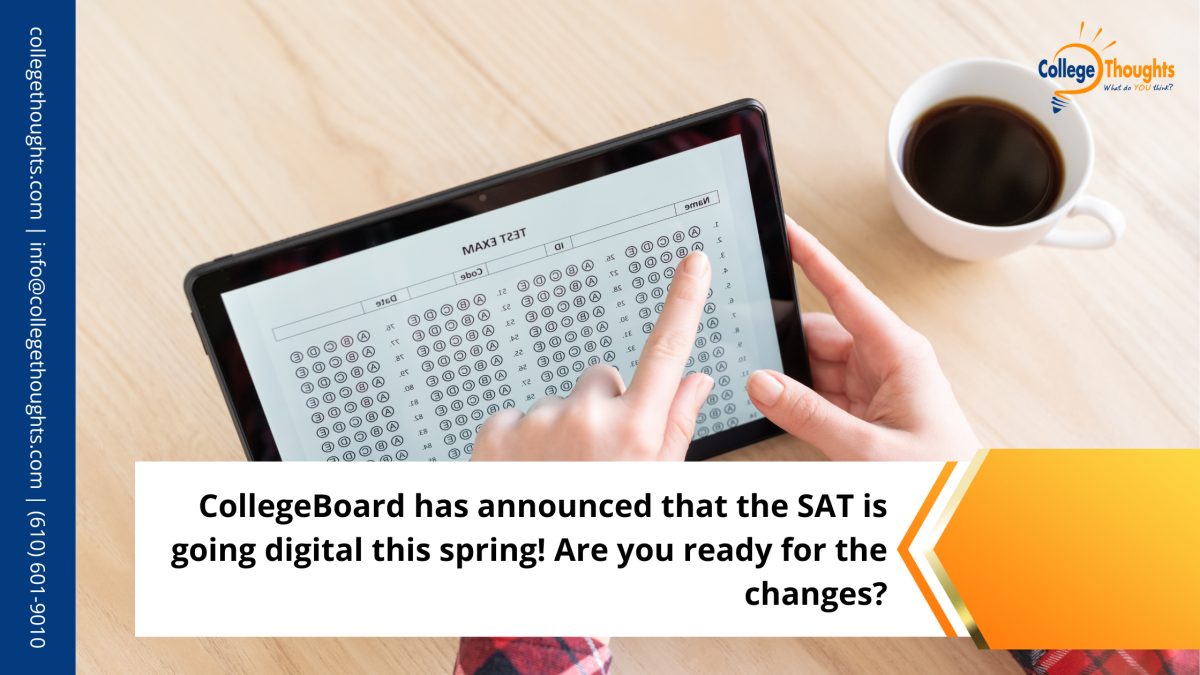
Affirmative Action: What Happens Now?
August 3, 2023
FAFSA Reinvented: A Guide to the Latest Changes
November 21, 2023
CollegeBoard is launching the digital SAT! Have you heard? The SAT and PSAT are going digital! Starting this October, rising juniors will take the digital PSAT as the qualifying test for the National Merit Society and all administrations starting in March 2024 will be digital as well! But what does that mean for students? What exactly is changing? How can you best prepare? In this article, we’re going to explore the changes, so let’s dive in!
What exactly is changing in the digital SAT?
The most obvious change, of course, is that this test will be held on a computer or tablet, instead of on paper. Students will be able to take this test either on their own personal devices or on devices provided by their schools. While there will be opportunities to charge devices should they run low during the test, students are responsible for remembering their charging cables, and we’d advise making sure all devices are fully charged before heading to the testing site. We also strongly recommend ensuring that your devices have had a proper shut down the night before.
Additionally, the test itself is shorter, taking about 2 hours instead of the current 3. The number of questions per section has been lessened as well, making the test easier to finish before encountering executive fatigue. In the new SAT, they have combined the separate Reading and Writing sections into one and broken it down into two stages. Similarly, in the math section, they have removed the no calculator portion altogether. The testing software also includes a built-in timer for students to individually gauge how much time remains in each section. There is the option to hide the timer from view, but it will automatically return at the 5-minute mark.
It’s also important to note that the digital SAT is adaptive, meaning that the second half of each section will either be easier or harder depending on your performance in the first half. The first half of each section consists of a mixture of easy, medium, and hard questions. As you make your way through, the software will track your performance based on the question difficulty. If you’re able to work your way through the more difficult questions, then the second section will consist of more medium and difficult questions. However, if you have trouble with some of the harder questions, then your second section will feature more easy to medium questions. Overall, this new system is designed to more accurately reflect a student’s abilities and acuity with certain subjects.
How does scoring work now?
First, it’s important to note that the overall scoring scale has not changed from the traditional test. The exam is still going to be scored out of a potential 1600, and CollegeBoard has said that the scores between tests are equal. For example, an 1100 on the traditional paper test is the same as an 1100 on the digital version.
However, the new version takes question difficulty into account rather than only counting the number of correct answers. Using Item Response Theory (IRT), the digital SAT relates a student’s performance on specific test questions to a student’s ability level in Math and English. IRT determines the probability of a student’s ability being in a certain place based on how they performed on questions of similar difficulty. At its core, IRT creates a curve for each individual question based on question difficulty, and each section of the test has a mixture of questions of varying difficulty levels.
IRT tracks the questions you’ve answered correctly in the first module to both start the scoring process and determine which second module you’ll encounter. At the end of the first module per section, the system has a general idea of what your score will be and uses the second module to further fine tune and calculate your final score. Your overall score still depends on the number of questions that you get correct. While it is true that answering the harder questions contributes to a higher score, the maximum score per section isn’t set. There’s no way to predict what questions will be in the first module, so the range of scores per section can’t be standardized.
How do I prepare for the test now?
Practice tests are going to be absolutely crucial in terms of preparation. CollegeBoard has renamed all of the areas that the test covers, and it’s important for students to familiarize themselves with the material to identify any problem areas. However, taking practice tests is the most surefire way to get instant feedback. As of right now, there are a few tests available through their new software, BlueBook. Using practice test performance to better understand any problem areas is the best way to get started with test preparation. We’d also recommend talking with a coach or guidance counselor to review the results and figure out exactly where to begin preparing and to create an effective timeline.
What if I don’t want to take the digital SAT?
We understand. This is a monumental change, and adjusting to it may not be right for you. If that’s the case, we’d recommend looking into taking the ACT instead. The ACT has remained steady, maintaining the same structure for at least the last 10 years. Preparing for the ACT has not changed, so if you feel like taking a digital test just isn’t the right fit for you, why not take a practice ACT and see if you respond well to it?
Not sure which test is right for you? Read our post about the differences between the SAT and the ACT. Make sure to also stay up to date on releases from CollegeBoard here!
Do you have more questions or would like to speak to someone about your specific situation? Give us a call at (610) 601-9010 or email us at info@collegethoughts.com!





